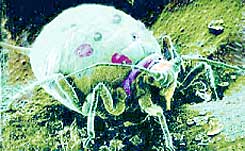All the aphids that live in Afz are genetically identical to each other. In such a situation, individuality is even more obscured than in an anthill or a beehive, and self-sacrificing behavior easily develops.

Leaf aphids don't seem like creatures willing to sacrifice their lives for their friends. But according to a study recently published in the journal "Proceedings of The Royal Society", this is exactly what they do.
The leaf aphids studied are not the ones that live on roses in gardens, but leaf aphids of the species Nipponaphis, Monzei that usually hide in aphids in tree branches (an aphid is a growth of the plant tissue around the insect eggs, where the insects develop from the eggs). Unfortunately for the aphids, the aphids are also attractive to other animals, especially larvae of certain species of moths, which enjoy the food and shelter that the aphids provide.
To test the reaction of the aphids to the invasion of these animals, Dr. Otaku Kurozu from the Tokyo University of Agriculture and Technology collected aphids and larvae from forests, brought them to her laboratory, punched holes in the aphids and inserted the larvae. In all cases the aphids attacked the larvae with a sticky white liquid, killing them. But when the aphids did this, they expelled about two-thirds of their body weight as liquid, which could cause their death. Other aphids plugged the holes with the sticky liquid. These aphids not only lost a large part of their body weight, but many of them sacrificed their lives directly - they were trapped inside the viscous material when it hardened.
The explanation for the self-sacrifice of the aphids is that the evolution of such behavior does not depend on the moral sophistication of the creatures, but rather on the genetic link between the sacrificers and those who benefit from the sacrifice. In ants, bees and wasps, insects in which cooperative and self-sacrificing behavior prevails, there is a special genetic system that causes females to be genetically closer to their sisters than to their daughters. This leads to the development of barren workers, whose role is to help the queen of the colony reproduce.
Something else happens with the aphids. All the aphids that live in Afz are genetically identical to each other. In such a situation, individuality is even more obscured than in an anthill or a beehive, and self-sacrificing behavior easily develops. The loss of a few "individuals" is not significant when the reproductive capacity of the entire colony increases. The aphids that sacrificed themselves were all young. Adult aphids, capable of reproduction, did not participate in the fight against the invaders.
Economist
